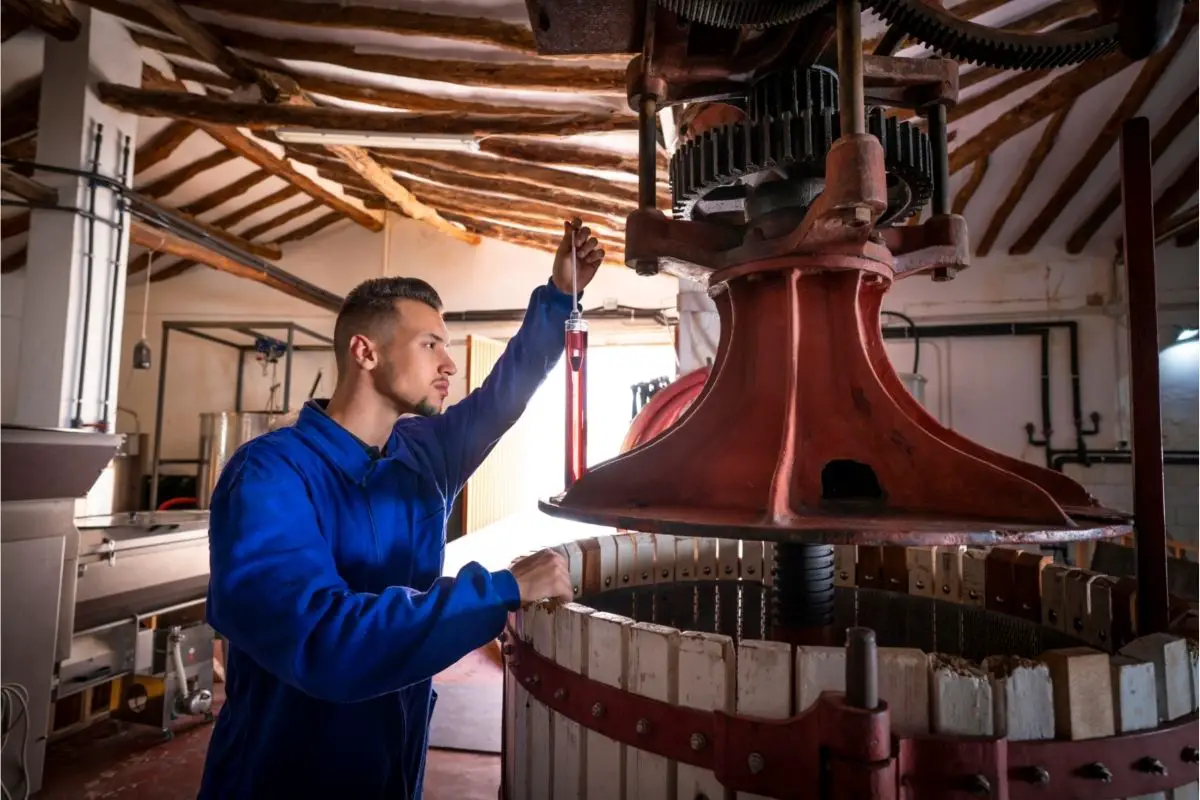If you drink alcohol, you may like kicking back with a cocktail, a glass of wine, or a can of beer every so often.
Commercial bottles of wine and beer will be labeled with an ABV percentage (alcohol by volume). This will tell you how much alcohol is in your beverage.
Some enthusiasts prefer to brew their beverages at home, but this presents a problem. Larger companies can analyze their bottles with lab techniques.

The regular person at home doesn’t have access to these, so it can be hard to figure out how much alcohol is in their blend.
Homebrewers can calculate the ABV of their beverages using two instruments. The first is a hydrometer which looks at density.
The second is a refractometer that measures sugar content. Both of these will work out the amount of sugar that transforms into alcohol as it ferments.
We’ll cover more about measuring alcohol content in this article, including how to use a hydrometer and how to use a refractometer.
What Is Alcohol By Volume?
If an alcoholic beverage has an ABV percentage on it, this will tell you the percentage of alcohol that is present in the drink.
For example, imagine that a beer can has a 5% ABV. If the beer was poured into 100 equal portions, five of those portions would contain alcohol, while the rest is full of other substances.
A single regular drink in the United States contains roughly 14 grams of pure ethanol.
Another different drink may have the same amount of alcohol within, but the ABV can be different. This is because serving sizes are a factor.
Here are some popular examples of alcoholic drinks. They all contain the same amount of ethanol, but have different ABV percentages.
- 5 ounces of wine – 12% ABV
- 12 ounces of standard beer – 5% ABV
- 1.5 ounces of a spirit (vodka, whiskey, rum) – 40% ABV
ABV percentages can also differ inside a group of alcoholic drinks. For instance, red wines like shiraz usually have a slightly higher ABV than white wines, like chardonnay.
How To Measure Alcohol Content
Now we’ll look at how you can measure the alcohol content of a particular drink.
Homebrewers will usually employ one of two ways of measuring alcohol content in their concoctions. The first is with a hydrometer, the second is with a refractometer.
Hydrometer
A hydrometer looks like a little tube with numbers written on it. The method involves immersing the hydrometer inside a sample of the beverage.
The tube will sink more or less depending on how heavy the alcoholic beverage is.
The alcoholic beverage’s density will change when it’s fermented. Before the fermentation process, the liquid is full of sugars that are yet to turn into alcohol.
This means that it will be denser, which is why the hydrometer floats easier beforehand. Once the fermentation process finishes, the sugars will turn into alcohol, so the hydrometer sinks more.
To measure the ABV of a beverage, you’ll need to measure two readings with the hydrometer. The first is taken before fermenting the beverage, the second is done after fermentation finishes.
These readings will tell you how much sugar has transformed into alcohol as the beverage is fermented. To work this out, simply subtract the first measurement from the second one.
Keep in mind that several factors may affect this process. Temperature can influence the beverage’s density.
Similarly, the amount of carbon dioxide bubbles that escape from the beer can make the liquid more or less heavier.
Refractometer
The second method of measuring the alcohol content of a beverage is by using a refractometer. This instrument measures how weak or strong any ingredient is when it’s dissolved.
Light changes direction when it passes through a liquid, a process called refraction. Refractometers look at the degree of the light as it refracts.
In the case of an alcoholic drink, alcohol, and sugar both affect how much the light changes direction inside the liquid.
Homebrewers and more experienced beverage makers use the refractometer to look at how much sugar is in the wort.
The wort is a liquid taken from the mashing procedure needed to create whiskey and beer.
The refractometer has a measurement scale, known as the Brix scale, which displays the sugar concentration. The wort will ferment after yeast is added to it, which transforms sugar into alcohol.
To work out the ABV, brewers will need to measure the wort’s sugar concentration before and after fermentation.
Certain factors, like temperature and the amount of alcohol created, will affect how much refraction happens during fermentation.
Several of these factors will need to be taken into account to get as accurate a reading as possible.
Refractometers are usually used to measure the initial sugar concentration before the fermentation process, but not as much as afterward.
This is because compared to hydrometers, refractometers often need more comprehensive corrections, so the results aren’t as accurate after fermentation.
How Do Larger Manufacturers Measure Alcohol Content?
Larger manufacturers and wineries can afford laboratories and more expensive methods to measure ABV. Two popular methods are gas chromatography and distillation.
Distillation involves boiling and condensing to separate alcohol from the rest of the liquid.
Gas chromatography is thought to be the most precise way of measuring alcohol content. The method involves converting the mixture into gas to separate and study each compound.
Next, the gas travels through a column full of a thick liquid. This is called the stationary phase, which separates different parts depending on their chemical and physical composition.
These are looked at in more detail using a detector.
The Bottom Line
The term ABV stands for alcohol by volume. This percentage tells you how much ethanol is within an alcoholic beverage.
There are two inexpensive ways to measure alcohol content, one involves using a hydrometer, and the other uses a refractometer.
A hydrometer looks at the density of a liquid, while refractometers assess sugar concentration. In both methods, readings are taken before and after fermentation to assess how much sugar has converted into alcohol.
Larger commercial manufacturers can afford more expensive methods of measuring alcohol content, which is usually more accurate.
Gas chromatography is thought to be the most accurate way of working out how much alcohol is within a beverage.
- Vevor Still Instructions - June 12, 2023
- Best Proofing Parrots For Home Distilling - February 1, 2023
- What Is A Porter Beer? - June 12, 2022
